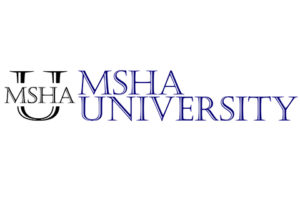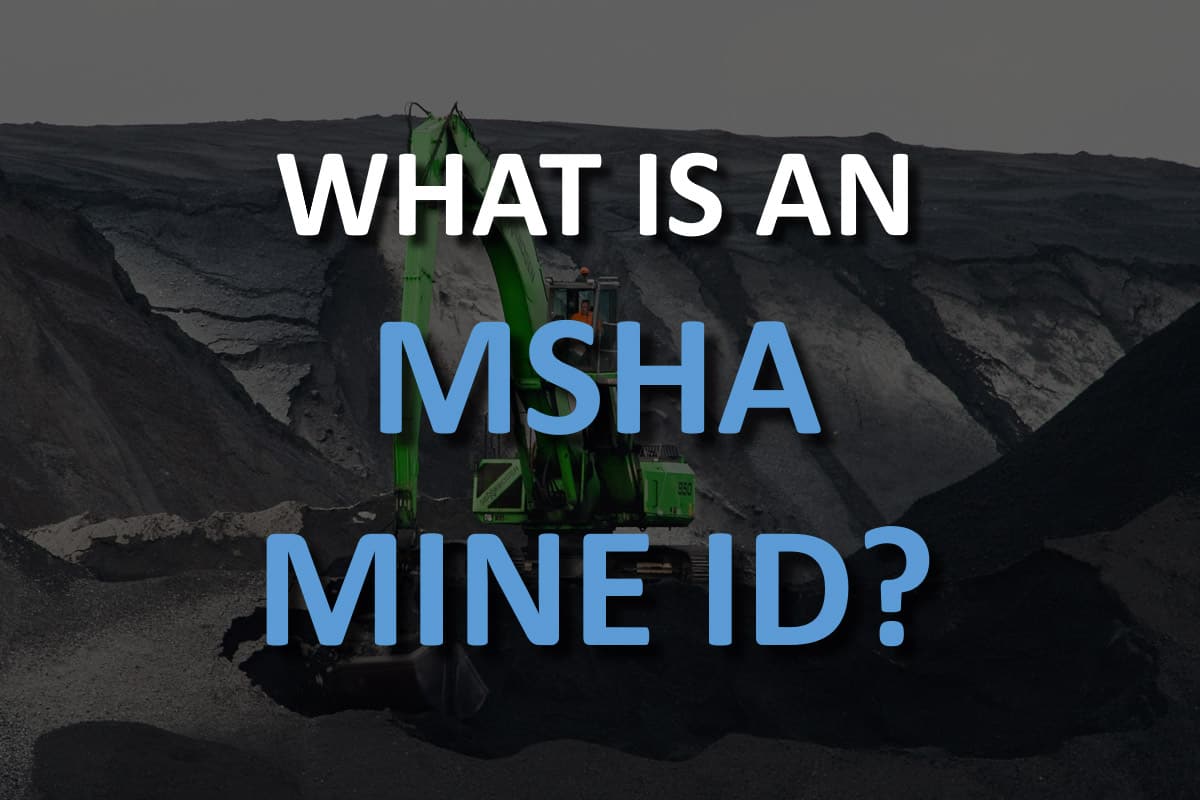For a mine that’s been in operation for years, an MSHA Mine ID (identification number) would have been assigned to the mine operator long ago. But when mining contractors are suddenly faced with complying with MSHA regulations, things can get very confusing. Here’s some information that helps answer questions about MSHA IDs.
So, what is an MSHA Mine ID and how do I get one? An MSHA Mine ID is a unique identifying number required for each U.S. underground and surface mine site before any operations may begin. Independent contractors performing services or engaged in construction work at a mine may also apply for an MSHA Contractor ID. And certain personnel applying for specific certifications, qualifications, or approvals are required to file for an MSHA Individual Identification Number (MIIN).
Getting an MSHA ID is the easy part. You can either apply online directly on MSHA’s website or submit the appropriate form to an MSHA District Manager in your area. But the bigger picture is about staying compliant with MSHA regulations. And there’s often a lot more involved with staying compliant and avoiding citations than just getting an MSHA ID. It’s extremely important to also understand what type of MSHA ID you may need and when each type is required.
What An MSHA ID Is And Isn’t?
An MSHA ID is simply a number assigned by MSHA to a mine site, contractor company, or an individual. An MSHA ID is not like a driver’s license or ID card. It’s not a form of identification in that way. It’s essentially just an identifying number that needs to be placed on forms and reports to track documentation.
TIP! – There’s no charge to file for an MSHA ID online and usually takes about 10 to 14 days to fully process. The filing will be routed to the regional office that has jurisdiction over your area so MSHA can do some basic research to ensure they’re assigning the ID appropriately.
What Type of MSHA ID Do I Need?
There are three basic types of MSHA IDs:
- Mine ID – for mine operators per mine site
- Contractor ID – for contractors performing work at a mine site
- MSHA Individual Identification Number (MIIN) – for a range of designated personnel, including MSHA-approved instructors
If you align with any of these ID types and are unsure if you should file for an ID, the safest path is to simply file for one online. There is no cost for filing and MSHA will typically issue a number when requested, with few exceptions.
MSHA uses these IDs as identifiers to track things like inspections, periodic reporting, training plan documents, and records of training as needed.
Who Needs An MSHA Mine ID?
A unique MSHA Mine ID is required for each surface mine and each underground mine site. Once a mine site has been assigned an MSHA Mine ID, that ID number stays with the site even if the site changes ownership, name, or operational status. And that number stays the same even if a mine site transitions from surface to underground mining operations or vice versa.
Both surface and underground mine operators can file online for an MSHA Mine ID to be assigned to a new mine site. This is the equivalent of filing the hard copy 7000-51 Mine ID Request Form with an MSHA Regional Manager.
TIP! – If you’re not a mine operator planning to open a new mine site or material milling plant, you don’t need to worry about filing for a Mine ID.
Who Needs An MSHA Contractor ID?
An independent mining contractor is effectively any person or company that performs services or construction work at a mine site for more than five consecutive days. Among other training and documentation requirements, MSHA requires mining contractors to acquire a Contractor ID when performing or are contracted to perform any of the following nine types of work at a mine:
- Mine development
- Construction or reconstruction of mine facilities
- Demolition
- Construction of dams
- Excavation
- Equipment installation
- Equipment service or repair (for more than five consecutive days)
- Material handling
- Drilling and blasting
And while MSHA doesn’t require contractors to file for an ID in order to bid for future work at a mine, be aware that some mine operators may require a bidding company to have a Contractor ID in advance. So, it may just help your chances to go ahead and file the 7000-52 Contractor ID Request Form online.
Once you have a Contractor ID, you will use that same number for all work your company performs at all mine sites.
TIP! – It’ll be way easier just to get a Contractor ID than to try and sort out whether you fit the requirements or not. So just file for a free one online. And remember that on any of the forms you’ll fill out (like the 5000-23 Certificate of Training), you’ll put your company name and Contractor ID anywhere it asks for the mine name and Mine ID.
Who Needs An MSHA Individual Identification Number (MIIN)?
An MSHA Individual Identification Number (MIIN) is only required for certain personnel applying for one of the following qualifications, certifications, or approvals:
Underground Mining
- Electrical Qualification Training (or Retraining), Low/Medium Voltage
- Underground Foreman
- Underground Assistant Foreman
- MSHA Approved Instructors (Part 48 and Part 49, Electrical)
Surface Mining
- Electrical Qualification Training (or Retraining)
- Surface Foreman
Both Underground and Surface Mining
- Methane/Oxygen Qualification
- Hoisting Qualification
- Explosives/Blasting Qualification
- Impoundment Qualification
- Preshift Examiner
- Respirable Dust Samples
- Respirable Dust Certification for Maintenance and Calibration on Dust Sampling Units
When an MIIN is issued, it will replace the individual’s social security number in all records as part of continued efforts to protect against identity theft.
TIP! – If you’ve never heard of this type of MSHA ID, don’t worry. It’s because you don’t need it unless you’re applying for any of the above qualifications, certifications, or approvals. So, one less thing!
When Is An MSHA ID Required?
Whichever type of MSHA ID you may need, a good rule of thumb is to file for one as soon as possible. Since filing is free and it can take up to about 14 days to receive one, the sooner you apply, the better. So, if you’re a contractor bidding for work at a mine site, you wouldn’t ever want the mine operator to pick another company simply because you didn’t already have an MSHA ID.
Related Questions
How Does MSHA Define An Independent Contractor?
The Code of Federal Regulations (CFR) Title 30 – Part 46.2 defines an independent contractor as “any person, partnership, corporation, subsidiary of a corporation, firm, association, or other organization that contracts to perform services at a mine.”
MSHA uses additional terms to identify mining contractors who are “regularly exposed” to mining hazards on a “frequent” or “extended” basis. This basically means that if your work at a mine site represents a patter of recurring exposer to mining hazards or exposure for more than 5 consecutive days (or both), you are considered an independent contractor.
TIP! – Keep in mind that once MSHA considers your company an independent contractor, all employees performing work at a mine site will have ALL the same training and documentation requirements as a miner.
What Information Is Required On The Contractor ID Request Form 7000-52?
It’s not uncommon for contractor companies bidding on projects at a mine site to file for an MSHA Contractor ID prior to securing that work. This can be done online by filing a 7000-52 Contractor ID Request Form that requires the following information:
- Trade name and business address
- Address of record for service of documents
- Telephone number
- Estimated annual hours worked on mine property by the independent contractor in the previous calendar year
What Is Yhe Mine Data Retrieval System (MDRS)?
One of the ways that MSHA uses IDs is to aggregate reported information on mining and provide that data to the public via a range of industry reports. The resulting reports can be accessed through an online portal called the Mine Data Retrieval System (MDRS).
Reports can be searched by:
- Mine ID
- Mine name
- State and county
- Contractor name
- Contractor ID
- Controller
- Operator
The reports output by the system include:
- Mine information
- Overview
- Accidents
- Inspections
- Violations
- Health samples
- Employment/Production
- And more
TIP! – The MDRS is a great resource for gathering information on the mining industry as well as for specific mines and mining contractors.
What Is The Difference Between A Miner And An Independent Contractor?
There is often a lot of confusion about how MSHA distinguishes between a miner and a mining contractor. But for practical purposes, the easiest way to understand this is that MSHA sees no distinction between miners and contractors when it comes to training and overall compliance.
Once a contractor, such as an electrical company, specialty tire provider, or welding service, performs work at a mine site and is deemed an independent mining contractor, MSHA requires exactly the same training and documentation for those independent contractor employees as they do for miners working every day at the mine site.
What Does “Metal / Non-Metal” Mining Mean?
When you’re researching MSHA regulations, you’ll likely come across the term, “Metal and NonMetal” (MNM). This can be a confusing term, since MSHA makes very clear distinctions between Part 46 surface mining and Part 48 underground mining. To make matters more confusing, there can be some overlap between MNM mining at the surface and underground.
Here’s a chart to help you understand how to interpret the MNM term with regard to underground and surface mining.


